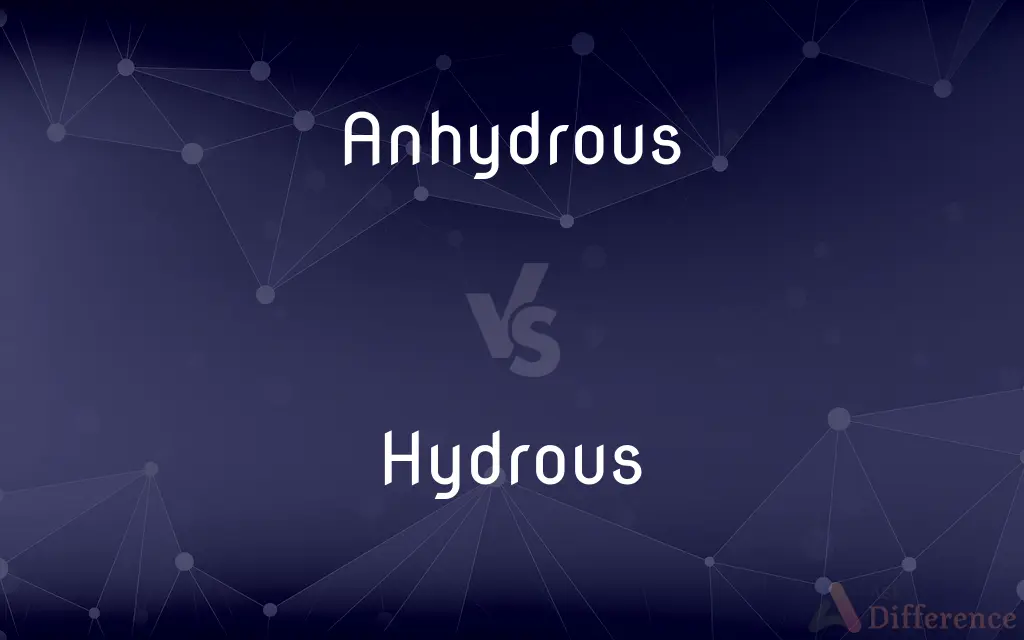Anhydrous vs. Hydrous — What's the Difference?
By Fiza Rafique & Maham Liaqat — Updated on March 21, 2024
Anhydrous substances lack water molecules, making them dry or without water, while hydrous compounds contain water molecules as part of their structure.

Difference Between Anhydrous and Hydrous
Table of Contents
ADVERTISEMENT
Key Differences
Anhydrous refers to chemicals or substances that do not contain water, particularly water of crystallization. This term is often used in chemistry to describe compounds in which water has been removed or that naturally occur without water molecules. Hydrous, on the other hand, includes water in its composition, which can be essential for the substance's structure or characteristics.
In practical applications, anhydrous compounds are used where the absence of water is critical, such as in drying agents or in reactions where water could interfere with the outcome. Hydrous compounds are significant in various biological, geological, and chemical processes, where the presence of water is necessary for the compound's stability or functionality.
The preparation of anhydrous compounds often involves the removal of water through heating or chemical reaction, making them more reactive or suitable for specific industrial and laboratory uses. Conversely, hydrous compounds may be formed through hydration reactions or naturally occur in hydrated forms, serving different roles in nature and technology.
For instance, anhydrous copper sulfate is a white powder that turns blue upon absorbing water, becoming hydrous copper sulfate. This transformation is a simple illustration of the difference between anhydrous and hydrous states and their applications in indicating moisture content.
While anhydrous substances are sought after in scenarios requiring low moisture content for efficacy or stability, hydrous materials play a crucial role in areas where water's physical or chemical properties are beneficial, such as in hydrating skincare products or in cement, where water contributes to the setting process.
ADVERTISEMENT
Comparison Chart
Definition
Lacking water, especially water of crystallization.
Containing water, particularly in a bound form.
Water Content
No water molecules present.
Water molecules are part of the composition.
Applications
Drying agents, reactions where water is detrimental.
Processes where water's presence is necessary.
Reactivity
Often more reactive due to lack of water.
Reactivity can be moderated by the presence of water.
Examples
Anhydrous ammonia, anhydrous ethanol.
Hydrous copper sulfate, hydrating skincare products.
Compare with Definitions
Anhydrous
Used to indicate the absence of water in chemical reactions.
Anhydrous conditions are required for this reaction.
Hydrous
Used to describe compounds formed with water.
Hydrous ferric oxide is a product of iron and water reactions.
Anhydrous
Lacking water within the structure.
Anhydrous calcium chloride is used as a desiccant.
Hydrous
Pertaining to materials that are wet or have water.
Hydrous tissues are essential for certain laboratory tests.
Anhydrous
Referring to substances from which water has been removed.
Anhydrous ethanol is preferred for certain chemical syntheses.
Hydrous
Containing water molecules as part of its composition.
Hydrous aluminum silicate is used in ceramics.
Anhydrous
Denoting a dry form of a substance.
Anhydrous milk powder has a longer shelf life than its hydrous counterpart.
Hydrous
Referring to substances that have absorbed water.
Hydrous ethanol contains a percentage of water.
Anhydrous
Pertaining to materials that naturally occur without water.
Anhydrous minerals are found in dry environments.
Hydrous
Indicating the presence of water in a compound.
Hydrous copper sulfate changes color when it loses water.
Anhydrous
A substance is anhydrous if it contains no water. Many processes in chemistry can be impeded by the presence of water; therefore, it is important that water-free reagents and techniques are used.
Hydrous
Containing water, especially water of crystallization or hydration.
Anhydrous
Without water, especially water of crystallization.
Hydrous
(chemistry) Containing combined water; hydrated.
Anhydrous
Having little or no water.
Hydrous
Containing water; watery.
Anhydrous
(chemistry) Having no water of crystallization.
Hydrous
Containing water of hydration or crystallization.
Anhydrous
Destitute of water; as, anhydrous salts or acids.
Hydrous
Containing combined water (especially water of crystallization as in a hydrate)
Anhydrous
Without water; especially without water of crystallization
Common Curiosities
How are anhydrous compounds used in industry?
Anhydrous compounds are used as drying agents, in chemical syntheses where water's presence is detrimental, and in applications requiring pure, concentrated substances.
What is the significance of hydrous compounds?
Hydrous compounds are important in biological processes, geological formations, and industrial applications where water's presence is essential for functionality or stability.
Can an anhydrous substance become hydrous?
Yes, an anhydrous substance can absorb water and become hydrous, which is often utilized in moisture indicator applications.
What does anhydrous mean?
Anhydrous means lacking water, especially water that is chemically bound within a compound.
What is an example of an anhydrous material in everyday life?
An example is anhydrous milk powder, used for its extended shelf life and reduced storage requirements.
How does the presence of water in hydrous compounds affect their properties?
The presence of water in hydrous compounds can influence their chemical reactivity, physical properties, and stability.
How can one convert a hydrous compound to an anhydrous form?
Removing water through heating or chemical means can convert a hydrous compound to an anhydrous form.
Can the transition from anhydrous to hydrous forms be reversible?
Yes, for many compounds, the transition between anhydrous and hydrous forms can be reversible through dehydration or hydration processes.
Are anhydrous products more effective than hydrous ones?
Effectiveness depends on the application; anhydrous products are preferred for their concentrated properties and lack of water, while hydrous products are chosen for their stability and reactivity with water.
Why are anhydrous conditions important in some chemical reactions?
Anhydrous conditions prevent unwanted reactions with water, enhance reactivity, and improve yields in certain chemical processes.
Why are anhydrous substances preferred in some medical applications?
Anhydrous substances are preferred for their lack of water, which can promote stability and prevent microbial growth in medical formulations.
How do hydrous and anhydrous compounds differ in their environmental interactions?
Hydrous compounds may interact more readily with environmental factors due to their water content, while anhydrous compounds might be more stable or reactive under dry conditions.
What role do hydrous compounds play in nature?
Hydrous compounds are integral to the water cycle, contribute to the structure of minerals, and are involved in various biological mechanisms.
Is it possible to have a hydrous form of any anhydrous compound?
Many anhydrous compounds can absorb water to form hydrous versions, but this depends on the chemical nature of the substance.
What is the importance of anhydrous solvents in laboratory settings?
Anhydrous solvents are critical in laboratory settings for reactions sensitive to water, ensuring that the outcomes are not compromised by moisture.
Share Your Discovery

Previous Comparison
Designate vs. Designee
Next Comparison
Finance vs. TreasuryAuthor Spotlight
Written by
Fiza RafiqueFiza Rafique is a skilled content writer at AskDifference.com, where she meticulously refines and enhances written pieces. Drawing from her vast editorial expertise, Fiza ensures clarity, accuracy, and precision in every article. Passionate about language, she continually seeks to elevate the quality of content for readers worldwide.
Co-written by
Maham Liaqat













































